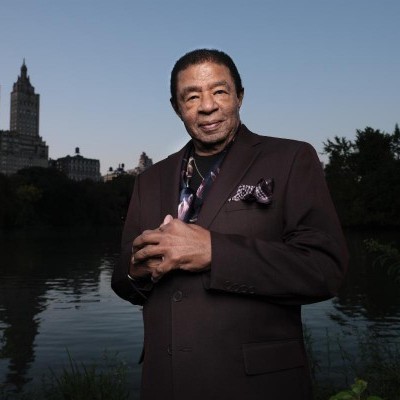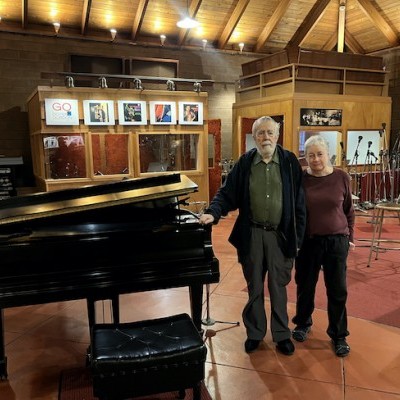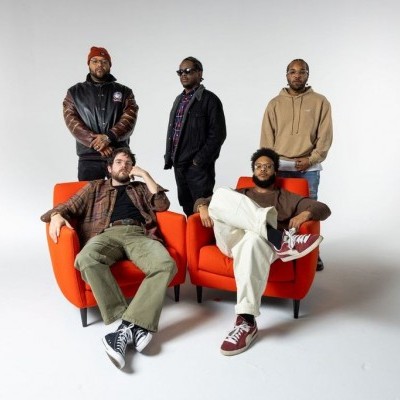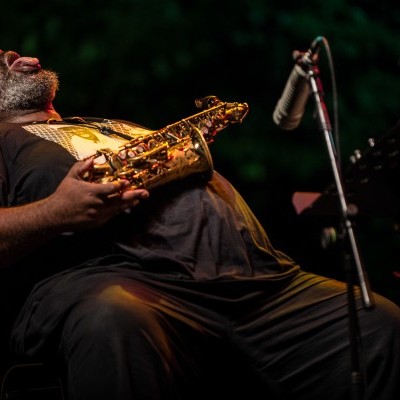Aug 26, 2025 1:53 PM
Blindfold Test: Buster Williams
Buster Williams, who at the age of 83 has been on the scene for 65 years, had never done a Blindfold Test. The first…

Gary Lucas (center, on stage) performs a live soundtrack to a screening of Too Much Johnson, a silent film by Orson Welles that was thought to have been abandoned by the director in 1938 and rediscovered in 2013.
(Photo: Phil Mango)Jan. 27 was a busy day for Gary Lucas. In the morning, he was at the United Nations Headquarters on Manhattan’s East Side, playing his arrangement of Leoš Janáček’s On An Overgrown Path for solo guitar as a part of the U.N.‘s International Holocaust Remembrance Day ceremony, appearing after speeches by the Secretary General and the Israeli and U.S. Ambassadors. And that evening, he was taking another dip into history, playing live accompaniment to a recently discovered Orson Welles silent comedy from 1938.
Lucas—a member of the final line-up of the legendary Captain Beefheart and the Magic Band whose many collaborators include Jeff Buckley and Peter Stampfel—has done live scores for 11 films, starting with The Golem in 1989. As a player, he has a style so recognizable—the fast and precise finger-picking, the full-body sound accentuated by a generous helping of reverb—that his performances don’t often hold much by way of surprises. But his love of the movies shines through in his accompaniments, often resulting in the most impassioned of his dynamic playing.
“When I was a boy, I was fascinated especially with horror films,” he said to the audience at Roulette in downtown Brooklyn before the screening of the Welles film. “I used to show them in my parents’ basement and charge the neighborhood kids a nickel.”
These days, he takes a bit more active a role in the process and charges a bit steeper an admission price than a nickel. But Lucas is still presenting unusual films to audiences and relishing in the opportunity.
On tap at Roulette was Too Much Johnson, a slapstick comedy abandoned by Welles in 1938, just three years before he revolutionized the cinema with Citizen Kane. The film was originally intended to be projected behind a stage show—with music by Paul Bowles—but technical and budgetary problems stalled the project. The footage was lost and, after years of speculation by Welles scholars, turned up in 2013 in a warehouse in Italy. An edit was made in an attempt to approximate Welles’ vision and has been screened a number of times since then. (It can also be seen on YouTube.)
Lucas made the unusual and ultimately rewarding decision to use the entire, unedited 66-minute reel instead of the streamlined cut.
“I think showing all these takes shows the absurdity of what you’re going to see,” Lucas said to the full house. “And what you’re going to see, I think, is one of the greatest, early Welles films.”
The narrative wasn’t quite cohesive, but the repeated takes on the shining big screen more than made up for it. A harrowing sequence of Joseph Cotton spinning on a rooftop holding a stepladder was worthy of Buster Keaton, and repeating reaction shots (two women holding each other and screaming, then pausing, then screaming, then pausing, then screaming again) brought a new kind of comedy to the show.
The repeated takes didn’t just underscore the humor, however. Such scenes as a character packing a suitcase that never seems to fill (comprised as it was of multiple quick takes yet to be edited down) meshed well with the loops Lucas built from his guitars and pedals. He didn’t go so far as to synchronize repeating audio/visual patterns, but the music and the video each had a way of folding back onto itself at any moment. It was linear storytelling twisted into knots.
Lucas briefly interpolated existing melodies into the soundtrack—which he said was about 50% improvised —to accentuate a pair of scenes with particular relevance today. When our hero (played by Cotton) attempted to hide from his pursuer by blending into a suffragist march, Lucas dropped in a few phrases from “The Star-Spangled Banner” as cheers arose from various parts of the room. Later, when the characters boarded a ship for Cuba, Lucas referenced Chuck Berry’s “Havana Moon.”
The appearance of the ocean liner (and of Berry’s bluesy licks) made for a welcome change of pace at about 2/3 of the way in. As the ship moved through the night, Lucas put down his acoustic and picked up his Stratocaster, which he played for the rest of the film. Deep bass loops and a loud, rumbling wash made for a dramatic shift in scene and a surprising finale when the last scene ended and Lucas, on cue, went silent. DB

“What I got from Percy was the dignity of playing the bass,” Buster Williams said of Percy Heath.
Aug 26, 2025 1:53 PM
Buster Williams, who at the age of 83 has been on the scene for 65 years, had never done a Blindfold Test. The first…

Don and Maureen Sickler serve as the keepers of engineer Rudy Van Gelder’s flame at Van Gelder Studio, perhaps the most famous recording studio in jazz history.
Sep 3, 2025 12:02 PM
On the last Sunday of 2024, in the control room of Van Gelder Studio, Don and Maureen Sickler, co-owners since Rudy Van…

The Free Slave, Cosmos Nucleus and Sunset To Dawn: three classic Muse albums being reissued this fall by Timer Traveler Recordings.
Aug 26, 2025 1:32 PM
Record producer and “Jazz Detective” Zev Feldman has launched his next endeavor, the archival label Time Traveler…

Butcher Brown, clockwise from top left: Marcus Tenney, DJ Harrison, Morgan Burrs, Corey Fonville and Andrew Randazzo. (Keyboardist Harrison couldn’t make the gig, so special guest Jacob Mann sat in with the band at the Reno Jazz Festival.)
Aug 19, 2025 12:41 PM
The band known as Butcher Brown has enjoyed the last half-decade basking in the glow from the twin engines of critical…

This year’s Jazz em Agosto set by the Darius Jones Trio captured the titular alto saxophonist at his most ferocious.
Aug 26, 2025 1:31 PM
The organizers of Lisbon, Portugal’s Jazz em Agosto Festival assume its audience is thoughtful and independent. Over…